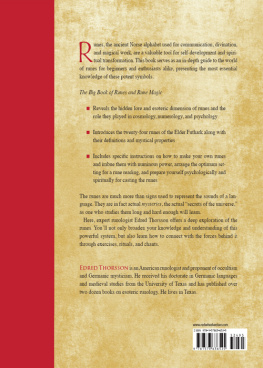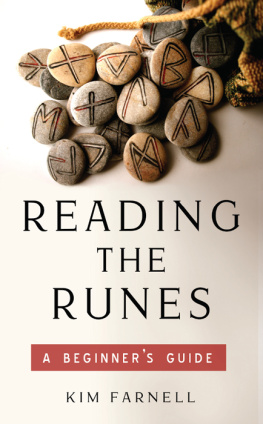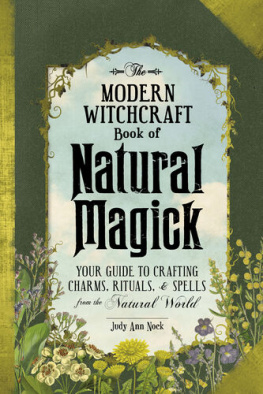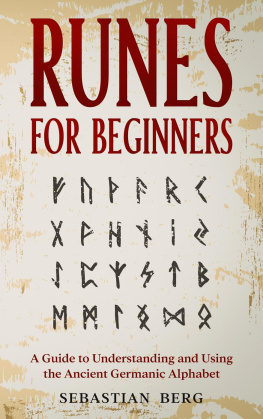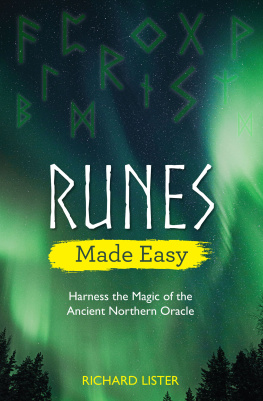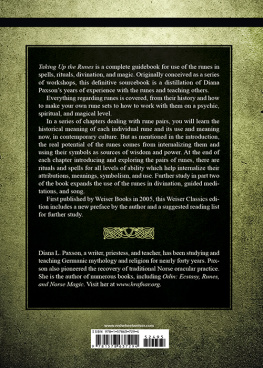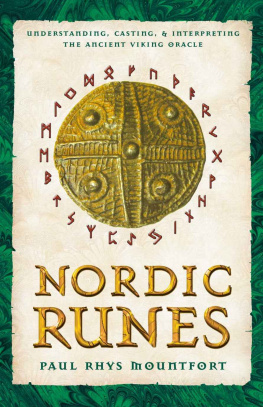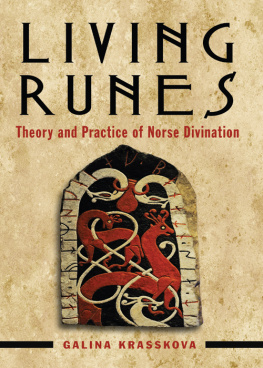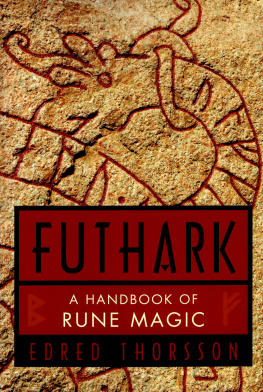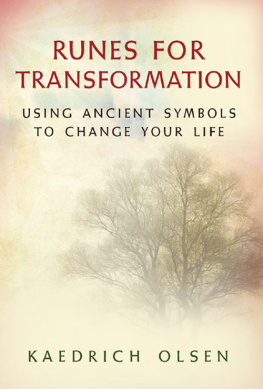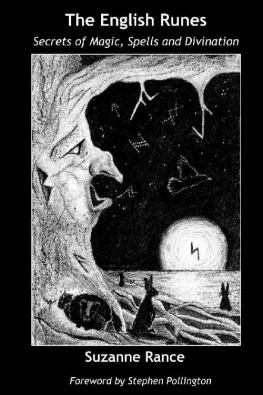
Copyright 2006, 2016
by Kim Farnell
All rights reserved. No part of this publication may be reproduced or transmitted in any form or by any means, electronic or mechanical, including photocopying, recording, or by any information storage and retrieval system, without permission in writing from Hampton Roads Publishing, Inc. Reviewers may quote brief passages. Previously published in 2006 as Simply Runes by Zambezi Publishing Limited, Devon, UK.
Cover design by Jim Warner
Interior design by Kathryn Sky-Peck
Hampton Roads Publishing Company, Inc.
Charlottesville, VA 22906
Distributed by Red Wheel/Weiser, LLC
www.redwheelweiser.com
Sign up for our newsletter and special offers by going to
www.redwheelweiser.com/newsletter/
ISBN: 978-1-57174-749-5
Library of Congress Cataloging-in-Publication Data available upon request
Printed in The United States of America
MG
10 9 8 7 6 5 4 3 2 1
www.redwheelweiser.com
www.redwheelweiser.com/newsletter
Contents
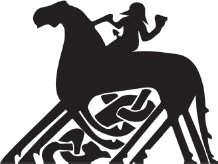

INTRODUCTION
The Origins of the Runes
I t is believed that the runes originally were derived from a northern Etruscan alphabet, which originated among peoples who dwelt in northern Italy and who spread into south central Europe. The earliest forms of runic writing developed among people who were living in Bohemia. At some point, the idea of using symbols as a means of communication traveled northward along the river routes to the lands in northern Europe and Scandinavia.
Pre-runic symbols have been found in various Bronze Age rock carvings, mainly in Sweden, and some of these are easily identifiable in later alphabets. Rune figures can be found chiseled into rocks throughout areas that were inhabited by Germanic tribes. These people shared a common religion and culture and their mythology was passed on through an oral tradition. The people of northern Europe used the rune script well into the Middle Ages. In addition to a written alphabet, runes also served as a system of symbols used for magic and divination, so in this way the process of writing became a magical act.
The arrival of Christianity in any particular Nordic area often resulted in a decrease or complete cessation of belief in local mythologies. However, it was the Vikings who colonized Iceland, so Christianity had a much weaker influence in that region. The pre-Christian myths were first written down in Iceland as a means of preserving them. When the Roman alphabets became the preferred script of most of Europe between the thirteenth and sixteenth centuries, rune writing fell into disuse. Interest in the runes began to rise again in the seventeenth century, but the Christian church soon banned them. Runes have now been rediscovered as a symbolic system and have become very popular as an accurate means of divination. Their meanings derive partly from life in ancient timesfor example, viewing cattle as a form of wealthand partly from the stories of the Nordic gods and Norse mythology.
Runic History in Detail
It is clear that the runes have always performed two functions: (1) that of containing, conveying, and imparting information through inscribed symbolsas a form of writingand (2) for purposes of divination and magic.
Before the Germanic peoples of Western Europe possessed a true alphabet, pictorial symbols were carved into stones. About 3,500 stone monuments in Europe, mainly concentrated in Sweden and Norway, are claimed to have been inscribed with runic types of pictures, symbols, and signs. The earliest of these writings date from about 1300 BC, and it is likely they were linked to sun and fertility cults. The names given to the runes indicate that a certain power was ascribed to them. The most famous users of the runes were the Vikings, who inscribed them everywhere they went.
The name rune means a secret thing or a mystery. When the high chieftains and wise counselors of Anglo-Saxon England met, they called their secret deliberations ruenes. When Bishop Wulfila translated the Bible into fourth century Gothic, he rendered St. Mark's the mystery of the kingdom of God and used the word runa to mean mystery.
When the Greek historian Herodotus traveled around the Black Sea, he encountered descendants of Scythian tribesmen, who crawled under blankets, smoked themselves into a stupor, and then cast marked sticks in the air and read them when they fell. These sticks were used as a kind of runic form of divination. By AD 100, the runes were already becoming widely known on the European continent.
The most explicit surviving description of how the runes were used comes from the Roman historian, Tacitus. Writing in AD 98 about practices prevalent among the Germanic tribes, he reports:
To divination and casting of lots they pay attention beyond any other people. Their method of casting lots is a simple one: they cut a branch from a fruit-bearing tree and divide it into small pieces which they mark with certain distinctive signs (notae) and scatter at random onto a white cloth. Then, the priest of the community, if the lots are consulted publicly, or the father of the family, if it is done privately, after invoking the gods and with eyes raised to the heavens, picks up three pieces, one at a time, and interprets them according to the signs previously marked upon them. (Chapter 10, Germania)
Runes were used to foretell the future by casting, and they were also inscribed into tools, weapons, and many other items. Runic letters were also used by the clergy as an alternative to the Latin alphabet.
According to Norse belief, the runes were given to Odin, the father of creation, who was able to communicate with his people through the runes and gave them warnings, blessings, and even curses from their enemies.
The runic alphabet, known as the Futhark, appears to have been derived from two distinct sources. The first is considered to be Swedish, where pre-runic symbols have been found in various Bronze Age carvings, while a second case has been made for a Latin and Greek derivation of the runic alphabet. The roots of the runes are still argued among scholars. The strongest evidence appears to point toward a north Italic origin. There are close parallels between the forms of the letters used in that area, in addition to the variable direction of the writing. Both Latin and Italic scripts derive from the Etruscan alphabet, which explains why so many runes resemble Roman letters. This would place the creation of the Futhark sometime before the first century BC, when the Italic scripts were being absorbed and replaced by the Latin alphabet. Linguistic and phonetic analysis points to an even earlier inception date, perhaps as far back as 200 BC. As time went on, runes became standardized throughout Europe, in some places the runes numbering as few as sixteen, in other areas as many as thirty-six; however, twenty-four runes formed the basic alphabet or Futhark. The Anglo-Saxons are credited with spreading the runes throughout Europe.
The Common Germanic Futhark remained in use among most of the Teutonic peoples until approximately the fifth century AD. It was at about this time that the first changes in the Futhark emerged on Frisian soil. The fifth and sixth centuries were a time of great change for the Frisian language, during which many vowels shifted in their sounds while new phonemes were added. This necessitated the expansion of the rune row, and in this first expansion four new runestaves were added to represent the new sounds in the Frisian language. The changes in the Frisian language also represented many of the changes that would be seen in Old English. Starting in the eighth century, more runestaves were added. It must be pointed out, though, that some of these staves are not proper runes, but rather pseudo-runes.
Next page

